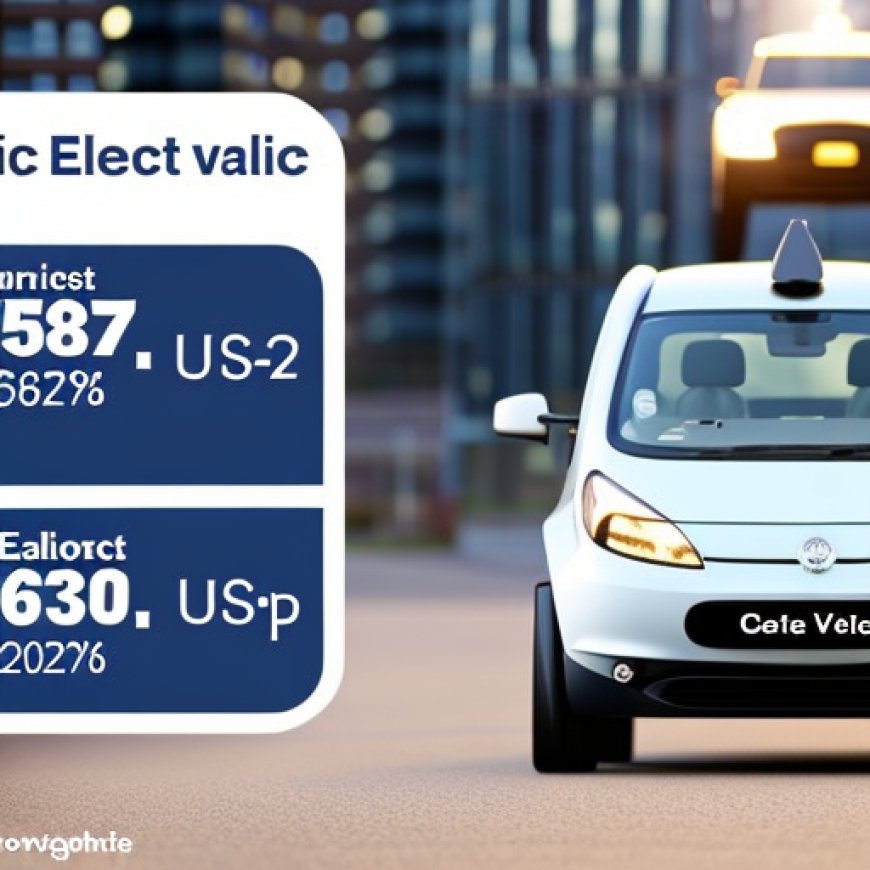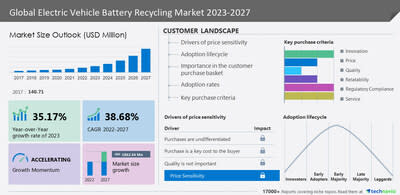Electric Vehicle Battery Recycling Market to grow by USD 1,862.56 million from 2022 to 2027|Growing adoption of electric vehicles boosts the market – Technavio
Electric Vehicle Battery Recycling Market to grow by USD 1,862.56 million from 2022 to 2027|Growing adoption of electric vehicles boosts the market - Technavio Yahoo Finance


The Electric Vehicle Battery Recycling Market is Set to Grow by USD 1,862.56 Million by 2027
NEW YORK, Aug. 3, 2023 /PRNewswire/ — The electric vehicle battery recycling market size is set to grow by USD 1,862.56 million from 2022 to 2027, progressing with a CAGR of 38.68%, according to the latest research report from Technavio. Discover Environmental & Facilities Services industry potential and make informed business decisions based on qualitative and quantitative evidence highlighted in Technavio reports. View Sample Report!
The Electric Vehicle Battery Recycling Market Covers the Following Areas:
- Electric Vehicle Battery Recycling Market Sizing
- Electric Vehicle Battery Recycling Market Forecast
- Electric Vehicle Battery Recycling Market Analysis
Company Landscape
The electric vehicle battery recycling market is fragmented and the vendors are deploying organic and inorganic growth strategies to compete in the market. Some vendors who are experts in the process industry are trying to increase their presence and market share by horizontally integrating with system integrators. End-users in discrete industries rely on their experiences from past purchases, based on which they maintain future relationships with vendors. This enables global and established RPA vendors to dominate the local and regional vendors in terms of quality, durability, reliability, and technological innovations. Hence, the competition among the vendors in the global R
SDGs, Targets, and Indicators
1. Which SDGs are addressed or connected to the issues highlighted in the article?
- SDG 7: Affordable and Clean Energy
- SDG 9: Industry, Innovation, and Infrastructure
- SDG 11: Sustainable Cities and Communities
- SDG 12: Responsible Consumption and Production
- SDG 13: Climate Action
- SDG 17: Partnerships for the Goals
2. What specific targets under those SDGs can be identified based on the article’s content?
- SDG 7.2: Increase substantially the share of renewable energy in the global energy mix.
- SDG 9.4: Upgrade infrastructure and retrofit industries to make them sustainable.
- SDG 11.6: Reduce the adverse per capita environmental impact of cities.
- SDG 12.2: Achieve sustainable management and efficient use of natural resources.
- SDG 13.2: Integrate climate change measures into national policies, strategies, and planning.
- SDG 17.17: Encourage and promote effective public, public-private, and civil society partnerships.
3. Are there any indicators mentioned or implied in the article that can be used to measure progress towards the identified targets?
Yes, the following indicators can be used to measure progress towards the identified targets:
- Share of renewable energy in the global energy mix
- Investment in sustainable infrastructure
- Environmental impact assessment of cities
- Resource efficiency and waste management
- Integration of climate change measures in policies and planning
- Number of partnerships for sustainable development
Table: SDGs, Targets, and Indicators
| SDGs | Targets | Indicators |
|---|---|---|
| SDG 7: Affordable and Clean Energy | 7.2: Increase substantially the share of renewable energy in the global energy mix. | Share of renewable energy in the global energy mix. |
| SDG 9: Industry, Innovation, and Infrastructure | 9.4: Upgrade infrastructure and retrofit industries to make them sustainable. | Investment in sustainable infrastructure. |
| SDG 11: Sustainable Cities and Communities | 11.6: Reduce the adverse per capita environmental impact of cities. | Environmental impact assessment of cities. |
| SDG 12: Responsible Consumption and Production | 12.2: Achieve sustainable management and efficient use of natural resources. | Resource efficiency and waste management. |
| SDG 13: Climate Action | 13.2: Integrate climate change measures into national policies, strategies, and planning. | Integration of climate change measures in policies and planning. |
| SDG 17: Partnerships for the Goals | 17.17: Encourage and promote effective public, public-private, and civil society partnerships. | Number of partnerships for sustainable development. |
Behold! This splendid article springs forth from the wellspring of knowledge, shaped by a wondrous proprietary AI technology that delved into a vast ocean of data, illuminating the path towards the Sustainable Development Goals. Remember that all rights are reserved by SDG Investors LLC, empowering us to champion progress together.
Source: finance.yahoo.com

Join us, as fellow seekers of change, on a transformative journey at https://sdgtalks.ai/welcome, where you can become a member and actively contribute to shaping a brighter future.








